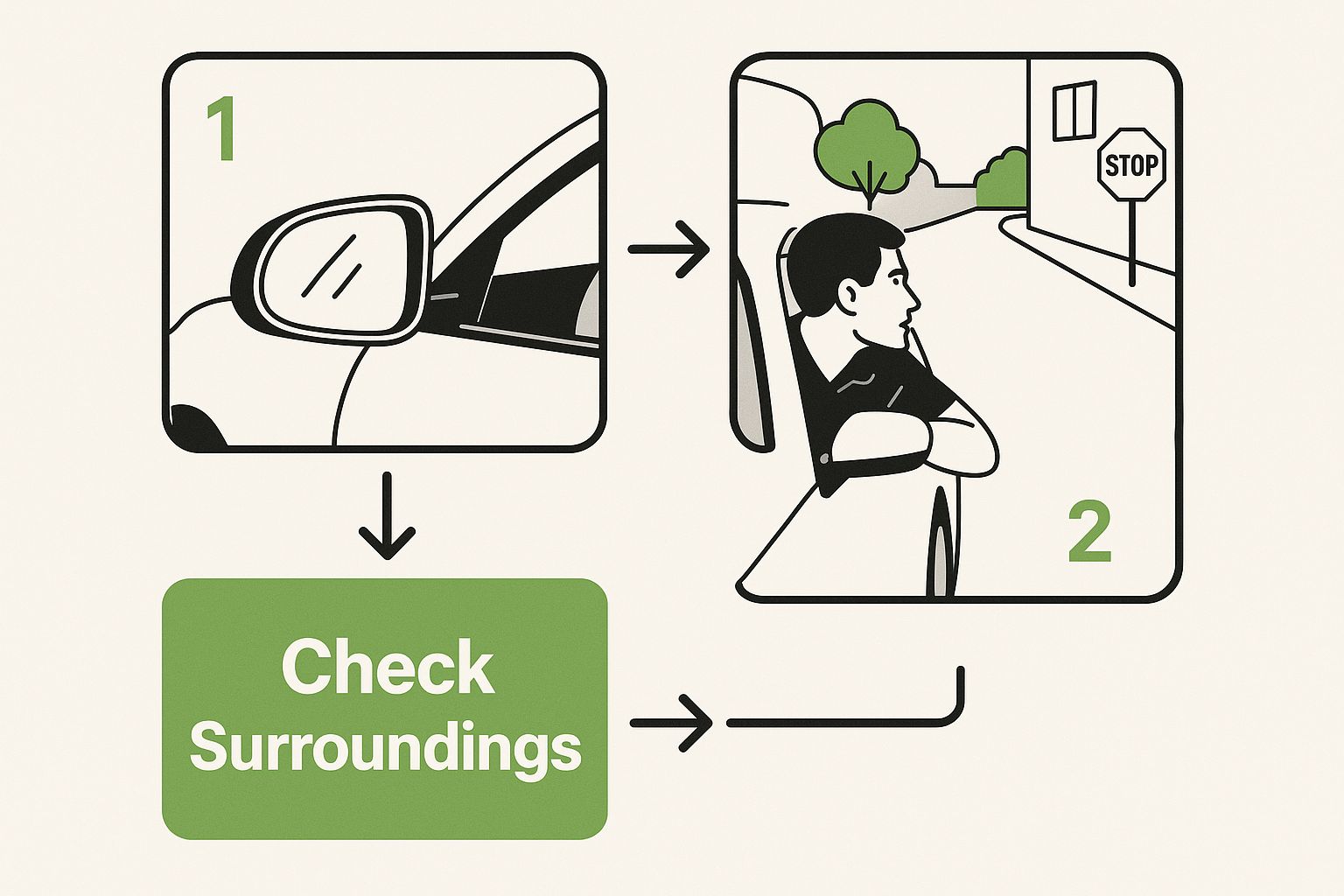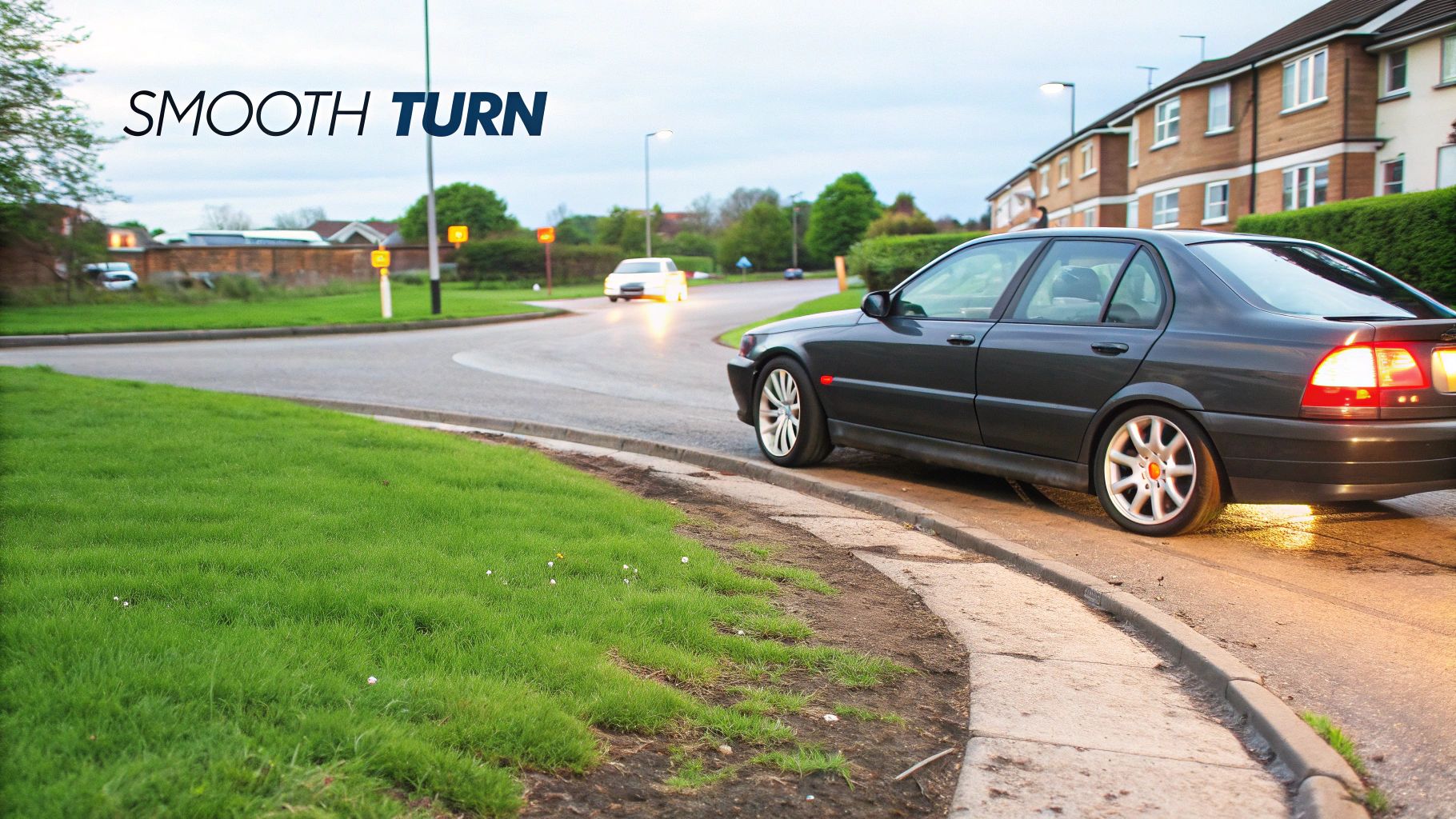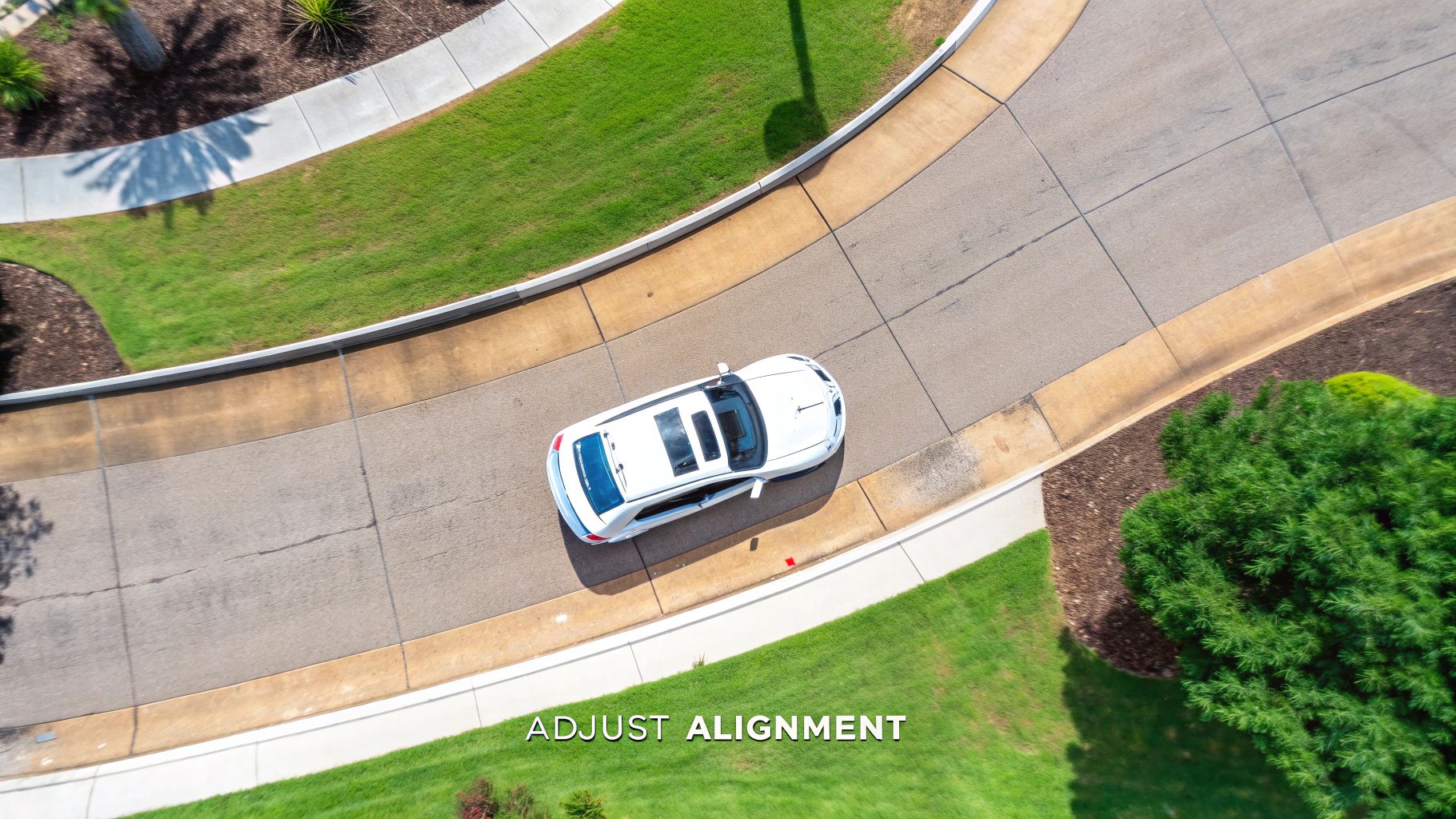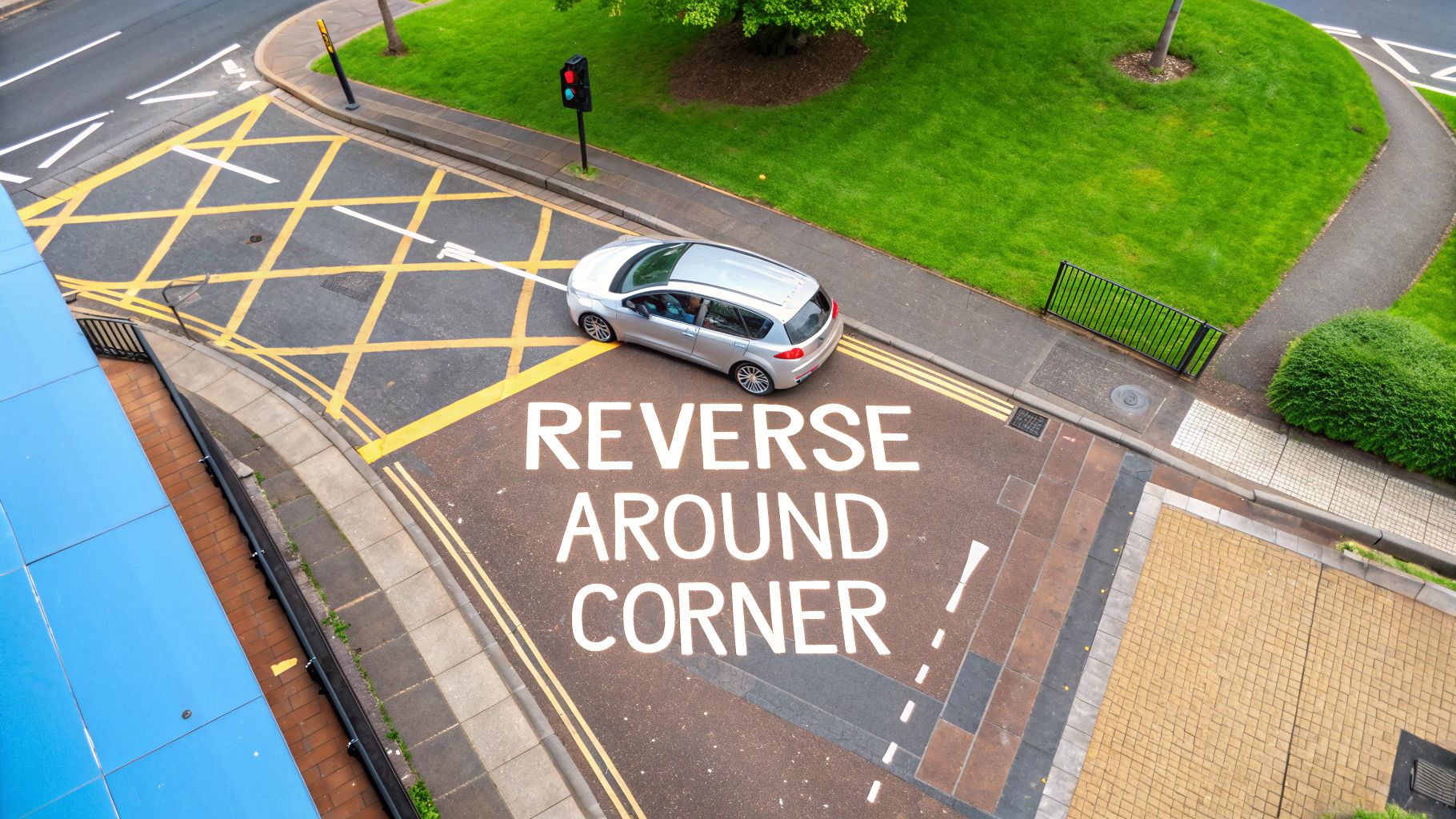Understanding The Reverse Around Corner Fundamentals
Reversing around a corner can be a challenging maneuver, even for experienced drivers in the UK. It's a test of more than just reversing skills; it demands spatial awareness, keen observation, and precise clutch control, all while navigating the complexities of UK roads. This is why it's a vital skill to develop, both for passing the practical driving test and for confident daily driving.
Mastering this maneuver goes beyond simply passing the test. It builds real-world confidence, enabling you to handle tight spots and tricky parking situations with ease. You'll be much better equipped to navigate narrow residential streets and awkward junctions, common features of UK roads. Furthermore, a solid understanding of the fundamentals makes learning other maneuvers, such as parallel parking, significantly easier.
The technique can differ between left-hand and right-hand corners due to the changing position of the kerb and your visibility. Therefore, identifying reliable reference points is essential for consistent success. These reference points, often specific to your car model, serve as guides, helping you judge distances and maintain accurate positioning. For example, aligning your door mirror with a kerb stone can indicate the optimal moment to initiate steering input.
However, successful execution isn’t solely about technique. It’s about understanding the spatial dynamics at play. Imagine maneuvering a large piece of furniture through a doorway—you need to accurately judge angles and distances to avoid collisions. Similarly, reversing around a corner requires anticipating your car's movement in relation to the kerb and other obstacles. Maneuvering errors, including this tricky turn, contribute to road incidents in the UK. Learn more about UK road safety statistics here: UK Road Safety. This highlights the importance of mastering this skill.
Finally, understanding the psychology of the challenge is crucial. Many drivers experience tension during this maneuver, affecting their judgment and reactions. By developing a calm and systematic approach, you can overcome these mental obstacles and reverse around corners with confidence and control.
Step-By-Step Reverse Around Corner Execution
This section provides the practical skills you need to reverse around a corner with confidence. We'll break down each stage of the manoeuvre, from initial positioning to final adjustments, sharing insights from experienced UK driving instructors. This goes beyond simply passing your driving test; it's about developing the competence to handle real-world driving situations.
The infographic below visualizes the crucial first step: checking your surroundings. It depicts a driver carefully observing their mirrors and blind spots at a typical UK street corner before starting the manoeuvre.

This initial observation emphasizes the importance of checking for pedestrians, cyclists, and other vehicles. This proactive approach is crucial for safe driving in the UK.
Setting Up For Success: Initial Positioning
Start by positioning your car approximately one metre away from the kerb, parallel to the corner. This gives you enough room to manoeuvre safely. This starting position allows for a smoother turn and reduces the risk of hitting the kerb.
Executing the Reverse: Steering and Observation
After checking your surroundings, select reverse gear and begin reversing slowly. Use the clutch to control your speed, maintaining a slow, steady pace. As your rear bumper aligns with the corner, gently apply full lock in the direction of the turn (right lock for a left turn, left lock for a right turn).
Maintaining Control: Mirror Checks and Adjustments
Regularly check your mirrors throughout the manoeuvre, focusing on your nearside mirror to monitor your distance from the kerb. If you're reversing around a left-hand corner, for instance, your left mirror is your primary guide. Adjust your steering as needed to maintain a safe distance from the kerb and avoid mounting the pavement.
Completing the Manoeuvre: Straightening Out
As your car straightens out onto the new road, adjust your steering wheel back to centre. This completes the reverse around a corner manoeuvre, leaving you positioned safely and correctly on the new street. This final adjustment ensures you're properly aligned for driving forward.
To summarize the key steps, let's review the following checklist:
This table provides a step-by-step checklist for reversing around a corner, outlining the actions required and key observations at each stage, as well as highlighting common errors to avoid.
| Stage | Action Required | Key Observations | Common Errors |
|---|---|---|---|
| Initial Positioning | Position car one metre from kerb, parallel to the corner. | Ensure sufficient space for manoeuvre. | Positioning too close or far from the kerb. |
| Executing the Reverse | Select reverse gear, reverse slowly, apply full lock when rear bumper aligns with corner. | Monitor mirrors, control speed using clutch. | Reversing too quickly, applying steering too early or late. |
| Maintaining Control | Regularly check mirrors, especially nearside mirror. | Observe proximity to the kerb, adjust steering as needed. | Not checking mirrors frequently, oversteering or understeering. |
| Completing the Manoeuvre | Straighten steering wheel when car is on the new road. | Ensure car is positioned correctly and safely on the new street. | Not straightening the steering wheel, swinging too wide. |
This detailed checklist helps reinforce best practices and minimizes common mistakes, ensuring a smooth and safe manoeuvre. This controlled and precise method will help you master reversing around a corner in any situation, proving especially valuable on the narrower streets often found in UK towns and cities.
Avoiding The Mistakes That Trip Everyone Up
Even seasoned drivers can find themselves caught in common reversing-around-a-corner traps. Let's explore how to avoid these pitfalls and develop a smooth, confident reversing technique. We'll examine the most frequent errors and discuss why they happen so often, even to experienced drivers.
Positioning Problems: Setting Yourself Up For Failure
One of the most common mistakes is improper initial positioning. Starting too close to the kerb restricts your turning radius and increases the chances of hitting it. Conversely, starting too far from the kerb can cause you to swing wide and potentially obstruct traffic. This is particularly important on narrower UK roads where space is often limited. Imagine navigating a removal lorry around a tight bend in a London side street – proper positioning is essential.
Observation Oversights: Missing Crucial Clues
Insufficient observation is another frequent error. Failing to properly check your mirrors and blind spots before and during the manoeuvre can lead to near misses with pedestrians, cyclists, or other vehicles. Reversing demands even more vigilance than driving forward. Focusing on only one mirror, like the nearside mirror when turning left, can create a blind spot on the opposite side, increasing the risk of a collision.
The Mental Game: Staying Calm Under Pressure
Many drivers experience tension during this manoeuvre, negatively impacting their judgment and reactions. This can result in jerky movements, oversteering, or even freezing up completely. It's similar to taking a penalty kick in football – the pressure can get to even the most skilled players. Managing these nerves is key to consistent success. For additional tips on staying calm in high-pressure driving situations, check out this guide: How to master and pass your driving test the first time around.
Troubleshooting Techniques: Correcting Common Errors
If you find yourself getting too close to the kerb, don't panic. Gently apply opposite lock to correct your path. If you're swinging too wide, apply more lock in the direction of the turn. These small, calm, and decisive adjustments can prevent minor errors from escalating into major problems. Much like a sailor adjusting their sails, you need to constantly adjust your steering to maintain the correct course.
Practicing Perfection: Building Lasting Confidence
Ultimately, mastering this manoeuvre comes down to practice. Find a quiet, safe area, such as an empty car park, and repeat the steps. This will build muscle memory and improve your ability to react smoothly in various situations. With consistent practice, your reactions will become more confident and automatic, allowing you to reverse around corners with ease and precision, even on the busiest UK roads.
Reference Points That Actually Work
The secret to confidently reversing around a corner? Establishing reliable reference points. These visual cues act as your guides, allowing for precise maneuvering and consistent success. It's similar to navigating by landmarks—you're using specific points on your car and in your environment to steer accurately.

Mastering Mirror Usage
Your car's mirrors are essential tools. For a left-hand turn, your left wing mirror is your primary reference. Align a specific point on your mirror, such as the edge or a marking, with the kerb just as your rear bumper clears the corner. This technique helps maintain a safe distance and prevents mounting the pavement.
For right-hand turns, your right wing mirror takes precedence. This directional approach ensures accuracy, regardless of which way you're turning.
Beyond the Mirrors: Door Frames and External Landmarks
Beyond mirrors, your car's door frame provides another helpful reference. While reversing, align the edge of your door frame with a specific point on the road or pavement. This acts as a secondary check, increasing your spatial awareness. For instance, aligning the bottom of your door frame with the edge of a manhole cover can indicate the ideal turning point.
External landmarks also play a role. Lampposts, road markings, or even unique building features can serve as distant reference points, helping you judge your car's overall trajectory.
Adapting to Different Car Models
Just as every street is different, so is every car. Different models, and even slight adjustments to your driving position, can impact your reference points. What works perfectly in one car might need adjustments in another. It's like adjusting a recipe—minor tweaks can make all the difference. Therefore, practicing in the specific car you'll be driving is crucial for calibrating your reference points accurately.
From Generic Advice to Personalized Precision
Generic driving advice, while useful as a starting point, rarely provides the specific guidance needed for consistent success. It's like using a standard map versus a personalized GPS—the latter offers directions tailored to your journey. By experimenting and developing your own system of visual cues, you'll gain a deeper understanding of your car's movement and how to maneuver it precisely. This personalized approach, along with consistent practice, builds the confidence needed to reverse around any corner with ease.
Adapting To Real-World Driving Conditions

While practicing reversing around a corner in a controlled environment is important, real-world driving in the UK presents unique challenges. This includes navigating narrow residential streets, busy main roads, and unexpected obstacles. This section explores how to adapt your reversing technique for the complexities of everyday driving.
Handling Obstructed Views and Unexpected Obstacles
Parked cars, overgrown hedges, and other obstructions can significantly reduce visibility while reversing. Slow down and proceed cautiously in these situations. If it's safe to do so, adjust your vehicle's position slightly to improve your view. For example, if a parked van obstructs your line of sight, inching forward a bit before reversing might provide a clearer view.
Pedestrians and cyclists can appear suddenly, especially in residential areas. Maintain vigilance during the maneuver, regularly checking your mirrors and blind spots. Be ready to stop immediately if someone walks or cycles into your path. This heightened awareness is crucial for safety on UK roads.
Navigating Awkward Junctions and Varying Road Conditions
Corners aren't always perfect 90-degree angles. Awkward junctions, such as T-junctions or sharply angled corners, may require adjustments to your standard reversing technique. You might find some helpful tips in this article: Driving Tips For Beginners. Challenging weather, like rain or fog, impacts visibility and road grip. Reduce your speed, increase your observation frequency, and steer more gradually in these conditions.
Knowing When to Choose an Alternative
Sometimes, avoiding reversing around a corner is the safest course of action. If conditions are particularly challenging, such as extremely narrow roads with heavy traffic, finding an alternative route or parking spot is a wiser choice. This demonstrates responsible driving and avoids potentially hazardous situations. Knowing when to adapt your plan is a vital skill.
Developing Sound Judgment Through Experience
Adapting to real-world driving involves more than learning specific techniques. It's about developing the judgment skills to assess each situation individually. Much like a chess player anticipates their opponent's moves, an experienced driver anticipates potential hazards and adjusts their strategy accordingly. This judgment comes with experience and a thorough understanding of road dynamics.
Building Unshakeable Confidence Through Smart Practice
Confidence while driving comes from a combination of understanding and deliberate practice. This section outlines a structured approach to practicing reversing around a corner, building genuine competence and not just passing familiarity. This is especially important for navigating UK streets, particularly narrow residential roads or complex junctions.
Creating Safe Practice Opportunities
Finding the right location is the first step. A quiet industrial estate on a weekend or an empty car park offers a safe, low-pressure environment. This allows you to concentrate on the technique without the stress of other traffic. It’s similar to learning to ride a bike in a park before venturing onto busy roads.
Setting Realistic Progression Goals
Start with easier corners and progressively increase the difficulty. Begin by reversing around a wide, open corner. As your confidence grows, move on to tighter corners and those with obstacles, simulating real-world situations like parked cars.
Tracking Your Improvement
Monitor your progress by noting how many attempts it takes to successfully complete the maneuver. The goal is consistent success. Also, observe how smoothly you execute the turn. As you improve, try to reduce your reliance on corrections. You might find this helpful: How to master any driving skills with intensive driving courses.
Practicing Independently
Practicing on your own is essential for developing muscle memory. Focus on each step, from your initial positioning to the final adjustments. Visualize the ideal path and deliberately execute each action. This focused practice reinforces your understanding of the technique.
Practicing With an Experienced Driver
Feedback from a qualified instructor or experienced driver can significantly speed up your learning. They can spot subtle errors in your technique and offer specific advice for improvement. This personalized guidance can be incredibly valuable for refining your skills.
Maintaining and Refreshing Your Skills
Even after you’ve passed your driving test, regular practice will keep your skills sharp. Just like a musician practices scales, occasionally practice reversing around a corner in a safe environment. This maintenance ensures you remain confident and competent throughout your driving career. By following this structured approach, you’ll not only master reversing around a corner but also develop lasting confidence for any driving situation on UK roads. This consistent effort will transform the maneuver from a potential source of anxiety into a demonstration of your driving skill.
Advanced Reversing Skills And Beyond
Successfully reversing around a corner is a major accomplishment. It also opens the door to more advanced driving techniques essential for navigating UK roads. This foundational skill serves as a building block for other complex maneuvers, enhancing your overall driving proficiency.
From Corners To Car Parks: Expanding Your Reversing Repertoire
The spatial awareness and vehicle control developed while reversing around a corner translate directly to parallel parking and bay parking. These maneuvers rely on similar principles: judging distances, steering accurately, and precisely controlling your car's movement. Understanding how your vehicle pivots around its rear wheels, for instance, is essential for both reversing around corners and smoothly entering tight parking spots on busy streets.
The Broader Benefits of Reversing Expertise
Beyond specific parking maneuvers, strong reversing skills offer significant practical advantages. They provide access to those often-challenging parking spaces found in crowded city centers, reducing the time and stress of searching for a spot. Improved reversing ability also enhances your control in difficult situations, such as navigating narrow lanes or maneuvering in confined areas.
Technology’s Impact on Traditional Skills
Modern driving technology, such as parking sensors and rear-view cameras, is changing how we approach reversing. These features can assist with judging distances and increase awareness of your surroundings. However, it's important to remember that these are supplementary aids. Fundamental skills like observation, control, and spatial awareness remain vital for safe and confident reversing, particularly in unpredictable real-world scenarios.
Sharing Your Expertise and Adapting to Change
Sharing your reversing skills with others can be a rewarding experience. Clear communication, patient guidance, and constructive feedback are key to helping learners master this maneuver. Road conditions and vehicle designs constantly evolve. Staying informed about these changes and adapting your techniques accordingly will ensure your reversing skills remain sharp and relevant throughout your driving career. By continually refining your skills and understanding, you transition from a competent reverser to a confident and adaptable driver prepared for any challenge UK roads present.
To help illustrate the progression of reversing skills, the following table provides a roadmap demonstrating how reversing around a corner connects to other advanced driving techniques.
| Skill Level | Manoeuvres Included | Practice Focus | Real-World Applications |
|---|---|---|---|
| Basic | Reverse around a corner | Clutch control, observation | Turning in narrow streets |
| Intermediate | Parallel parking, bay parking | Steering precision, judgment | Parking in tight spaces |
| Advanced | Multi-point turns, reversing with a trailer | Spatial awareness, planning | Complex manoeuvres, towing situations |
This table demonstrates how the basic skill of reversing around a corner provides a foundation for intermediate skills like parallel and bay parking, eventually leading to more advanced techniques such as multi-point turns and reversing with a trailer. Each level emphasizes different practice areas, reflecting the increasing complexity and real-world application of the skills.
Ready to accelerate your driving journey and master these essential skills? Book your driving course with Fast Pass Driving Courses today and experience the confidence that comes with expert instruction and personalized support.

